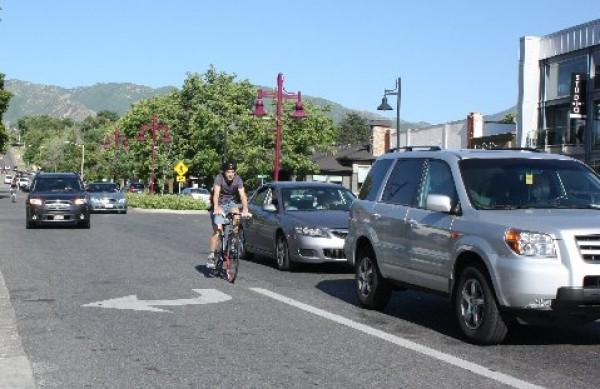
There were a lot of local cheers when the national nonprofit group League of American Bicyclists ranked Utah as the 13th most bike-friendly state in the country. It was quite a jump up from our previous ranking of 31st.
But the change actually began eight years ago, with the death of 25-year-old Josie Johnson, who was hit and killed by an SUV in 2004 as she rode up Big Cottonwood Canyon. She was the third Utah cyclist to be killed by a vehicle over a period of five weeks. At the time, there were more than 800 injuries a year to bike riders hit by cars and trucks. Bike activists began lobbying the Legislature for laws to make bicycling more safe.
That’s when the “three-foot rule” was passed. House Bill 49 requires drivers to maintain a safe distance when passing a bike rider, with a minimum of three feet where possible.
The rule, while still not always obeyed, started a process of educating drivers to “share the road”—to be more aware of people on bikes. Since then, the number of bike lanes and people who use them have increased dramatically.
Ryan Littlefield, owner of Contender Bicycles in Salt Lake City, says, “Motorists are now more practiced at dealing with bicycles. They are realizing that riders are often going faster than they thought.”
Littlefield expects city areas to become even more crowded with bikes. “I think as parking becomes tighter and tighter downtown, people will use their bikes more when going into the city, or take their bikes on mass transportation, then use it to get where they’re going,” he says.
He also commends steps taken in the direction of more bike friendliness, pointing out that the shoulder in Emigration Canyon has been improved, and a good job is being done of keeping the road clean. “But at the same time, there’s room for improvement,” he says.
One of the biggest improvements would be to educate homeowners and city workers not to put things like garbage cans or traffic barricades in bike lanes. It endangers a cyclist who has to swerve out into traffic to avoid a blockage of the bike lane. Even road maintenance in canyons or hillsides can be an issue if rocks have fallen to the road shoulder, narrowing the safe area for riders and making navigation more challenging.
Using bikes for transportation rather than just for exercise or training is also becoming more common. But it’s a habit that has to be ingrained. You can start by making at least one trip a week by bike, whether it’s to the grocery store or to a coffee shop. Gradually increase your number of trips and the mileage. If your destination is less than two miles away, use a bike instead of a car. Have lights on the bike and a vest with reflective tape for night riding.
Many Wasatch Front cities are responding to increased bike usage by creating more bike lanes. Sandy City installed new lanes when State Street, 700 East and 1300 East were all widened. Dan Medina, Sandy’s assistant parks & recreation director, says, “We’re currently amending our 2005 Master Plan of the trails and bike lanes in the city. We have 44.1 miles of bike lanes, and they may be increasing that number. The new bike lanes will be on Wasatch Boulevard, Highland Drive, 1300 East and 700 East. Those are all the north-south streets. East-west will be Newcastle Drive, Sego Lilly Drive and 11400 South. I noticed that since we did the 700 East portion, there are more bicycle riders using those routes.”
Taylorsville is also planning more bike lanes. Mayor Russ Wall says, “We’re continually doing new road construction, and as the road projects come through, we put in bike lanes.
We’re going to be putting a new bike lane on 2700 West, between 4100 South and 6400 South, between our southern and northern border—more than three miles. We’re also working on designing more bike lanes.”
With the increasing number of bike riders, bike lanes and motorist awareness in Utah, we may be edging closer to being the most bike-friendly state in the nation when next year’s ranking come out.